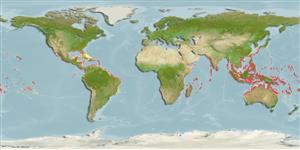Holothuroidea |
Holothuriida |
Holothuriidae
Environment: milieu / climate zone / εύρος βάθους / distribution range
Οικολογία
Υφαλόφιλο(α); εύρος βάθους 0 - 12 m (Αναφ. 122). Tropical
Indo-Pacific.
Length at first maturity / Μέγεθος / Weight / Age
Γεννητική Ωρίμανση: Lm ?, range 12 - ? cm Max length : 36.0 cm TL αρσενικό/απροσδιόριστο; (Αναφ. 101468); common length : 20.0 cm TL αρσενικό/απροσδιόριστο; (Αναφ. 122); μεγ. δημοσιευμένο βάρος: 1.0 kg (Αναφ. 418)
Body width: 10 cm. Maximum weight: 1000 g (Ref. 418); 300 g. Body thickness: 0.7 cm. Elongate, arched dorsally (bivium) and flattened ventrally (trivium). Bivium sometimes wrinkled and covered by sediment; wider in the middle; tapering towards both ends. Papillae on bivium long and slender; podia on trivium arranged more or less regularly in 3 rows calcareous disc surrounded by 5 anal teeth. Calcareous ring with large radial pieces and narrow interradial. Cuvierian tubules few (10); short, pink, and never expelled. Bivium is brown, varying from light to dark among specimens; trivium lighter, sometime orange, with yellow podia. Ventral tegument with a variety of small rosettes and rods, occasionally perforated; dorsal tegument with larger rosettes and branched plates; ventral podia with some straight, spinous rods; tentacles with rods large, straight , or curved, and very spiny at their extremities (Ref. 122).
Harvested in artisanal fisheries throughout the Western Central Pacific. Processed product is not distinguished from those of other Actinopyga species and has a moderate commercial value. Collected by hand while wading on the reefs at low tide (Ref. 122). Dwells in moderately shallow waters (despite its English common name), in sandy areas with large amounts of coral rubble; mostly on reef flats of fringing and lagoon-islet reefs; abundant in seagrass beds, on rubble flats, and compact flats where populations can reach high densities (up to 1/m) (Ref. 122); it attaches to rocks with its tube feet (Ref. 118).
Sexual reproduction takes place during warm season. A species with a high potential fecundity and early sexual maturity (Ref. 122).
Conand, C. 1998 Holothurians (sea cucumbers, Class Holothuroidea). p. 1157-1190. In Carpenter, K.E. and V.H. Niem (eds.) FAO Species Identification Guide for Fishery Purposes. The Living Marine Resources of the Western Central Pacific. Vol. 2. Cephalopods, crustaceans, holothurians and sharks. FAO Rome. (Αναφ. 122)
IUCN Red List Status
(Αναφ. 130435: Version 2025-1)
CITES status (Αναφ. 108899)
Not Evaluated
Not Evaluated
Threat to humans
Human uses
αλιεία: Εμπορικό(ά)
| FishSource |
Εργαλεία
Περισσότερες πληροφορίες
Τροφική ΟικολογίαFood items (preys)
Σύσταση δίαιτας
Κατανάλωση τροφής
Θηρευτές
PhysiologyΚατανάλωση οξυγόνου
Human RelatedStamps, coins, misc.
Διαδικτυακές πηγές
Estimates based on models
Preferred temperature
(Ref.
115969): 25 - 29.3, mean 28.4 (based on 3693 cells).
Ελαστικότητα
Χαμηλό, ελάχιστος χρόνος για διπλασιασμό πληθυσμού 4,5 - 14 έτη (K=0.09).
Fishing Vulnerability
Moderate vulnerability (44 of 100).
Price category
Unknown.
